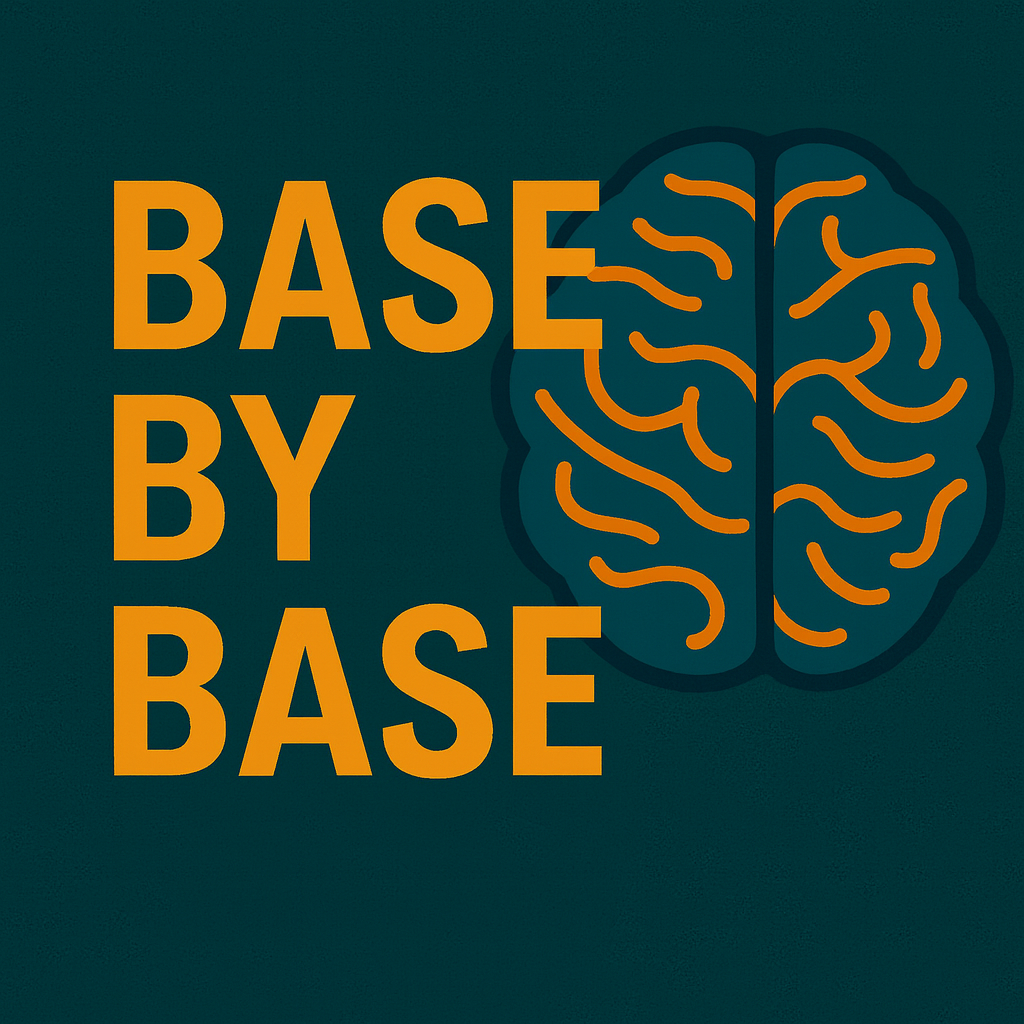Episode Transcript
[00:00:00] Speaker A: Foreign.
Welcome to Base by Base, the papercast that brings geomics to you wherever you are. Today, we're diving deep into a condition that, well, it profoundly impacts millions of lives globally. Schizophrenia. Have you ever really considered the sheer personal weight and the societal weight to. Of this disorder? It's often, you know, kind of shrouded in mystery. The symptoms can be incredibly varied, deeply personal. And current treatments, they're helpful, sure, but they often fall short of like, full recovery. So the big challenge for researchers for a long time really has been how do we pinpoint the precise genetic factors. Especially for something so complex, so debilitating and, well, so varied between people. It feels a bit like trying to find these tiny, specific pieces in a huge, really intricate puzzle. Right? Maybe each piece holds a totally different clue. But what if, what if a massive new effort has finally managed to nail down some of these elusive genetic culprits with like, unprecedented clarity? Just imagine how that knowledge could fundamentally shift our whole approach from understanding its roots to maybe, just maybe developing more targeted, more effective treatments. So get ready, we're going to explore that possibility today. Okay. But before we really dig into the nitty gritty, we absolutely want to recognize the incredible effort behind this specific work. Today we celebrate the groundbreaking research from Cardiff University's center for Neuroscience, Psychiatric Genetics and Genomics. And of course, there are many, many collaborators across the globe. Their dedication has really pushed the boundaries here, advancing our understanding of schizophrenia's genetic architecture.
[00:01:44] Speaker B: Yeah, it's truly fascinating, the complexity of schizophrenia, both clinically, like you said, and genetically. It's this severe psychiatric syndrome. Right? Broad spectrum of behavioral, cognitive symptoms, and often these persist throughout a person's life. Current antipsychotics, they're vital, absolutely, but they don't always lead to complete resolution for everyone. And genetically, we know it's highly polygenic, that's the key term. So it's not just one faulty gene causing it. It's more like the subtle interplay of thousands of genetic variants, each one just contributing a tiny little bit to someone's overall likelihood, their risk. Think of it like, I don't know, a super complex recipe, Lots of ingredients, even tiny amounts shaping the final dish.
[00:02:25] Speaker A: Okay, so a mosaic of influences, not one big genetic light switch. What do we actually know about this genetic landscape before this latest study?
[00:02:33] Speaker B: Well, we had some crucial glimpses from previous large scale studies, really important work. We knew, for instance, that common genetic variations, the ones found in, say, more than 1% of people, they already explain a pretty significant chunk of the risk, maybe around 24% or so big studies, GWs, they identified hundreds of locations in the genome pointing ToWards know over 100 specific protein coding genes that might be involved.
[00:02:57] Speaker A: Okay, so common variants gave us some leads. What about rarer changes?
[00:03:01] Speaker B: Right, then you have the rare variants, less than 1% frequency. These include things like copy number variants or CNVs, that's where bits of DNA are deleted or duplicated. And also ultra rare coding variants, like tiny typos right inside the genes themselves, very infrequent. Now these rare variants, they account for maybe 5% of the variants overall. But and this is important, they often have a much stronger individual impact. We'd already found about 13 rare CNVs linked to risk, with one gene, NRXN1 being a really key example where a deletion seriously bumps up the risk.
[00:03:34] Speaker A: NRXN1. Right, I remember that one.
[00:03:36] Speaker B: And these ultra rare coding variants, they tend to cluster, they're concentrated in about 3,000 specific genes, genes that are under what we call strong selective constraints.
[00:03:47] Speaker A: Okay, selective constraint, that sounds important.
Can you unpack that a little? What does that mean exactly?
[00:03:52] Speaker B: Yeah, sure. So when a gene's under strong selective constraint, it basically means that nature really doesn't like changes in that gene. Even small mutations are often very harmful. Evolution tends to weed them out because they negatively impact survival or having offspring. So finding rare but potentially high impact variants in these highly constrained genesis, it's a big flag. It tells you these genes are crucial for fundamental biology. And disrupting them that could have really profound consequences like contributing to a condition like schizophrenia.
[00:04:24] Speaker A: Got it. So these are mission critical genes. If they go wrong, the impact is likely pretty substantial. And we had some earlier big efforts. Right, like the Schema Consortium and the pgc, they gave us some initial clues.
[00:04:35] Speaker B: Exactly. Those consortia were absolutely instrumental, huge collaborations.
Schema for example, they identified 10 genes with very high confidence, what we call exome wide significance back then, and another 22 that look really promising at a slightly lower confidence level. FDR, less than 5%. The PGC, the psychiatric genomics Consortium, they implicated a couple more as well. And these early findings were already pointing towards crucial biological pathways, things getting disrupted like glutamatergic synaptic signaling. That's basically how brain cells talk to each other at junctions. And also the whole comple world of transcriptional regulation, how genes are turned on and off. But you know, even with those vital clues, huge parts of this genetic puzzle were still completely missing.
[00:05:19] Speaker A: Right, and that's exactly where this new study steps in. The big goal was just more power to dramatically boost the Statistical power for finding more genes, hoping to light up more pieces of that puzzle.
[00:05:28] Speaker B: Yeah.
[00:05:29] Speaker A: How did they actually manage that? It sounds like a massive undertaking.
[00:05:32] Speaker B: It really was. They knew they had to go bigger than ever before. The key was adding a huge amount of completely new data.
So this study performed whole exome sequencing, that's sequencing all the protein coding bits of DNA on a completely new sample. Over 4,600 individuals with schizophrenia and nearly 6,000 controls without it. And the really crucial part, none of these people had been in any previous exome sequencing studies for schizophrenia.
[00:05:55] Speaker A: Ah, so genuinely new information, a fresh pool of data.
[00:05:59] Speaker B: Exactly. A clean slate. Adding fresh genetic insights. And then they didn't just stop there. They took this new high quality data and very carefully combined it, meta analyzed it with all the previously published sequencing data that was out there. The result just. Well, the largest whole exome sequencing study of schizophrenia to date, period. Bringing together totals that are just staggering. And nearly 29,000 cases, over 103,000 controls, plus over 3,400 families, trios with a pro band, the affected child and their parents, where they could specifically look for brand new de novo mutations. That is an incredible amount of genetic information.
[00:06:34] Speaker A: Wow, that sounds like trying to find not just a needle in a haystack, but needles in a whole field of haystacks. What kind of needles? What kind of variants were they specifically looking for in all that data?
[00:06:44] Speaker B: Good question. Their main focus was on those rare coding variants. Those subtle but potentially very powerful changes inside genes that you just don't see very often in the general population. Specifically ones with a minor allele count or Mac of 5 or LEFS. Very rare. And to make sense of this absolute mountain of data, they use really rigorous statistical methods, sophisticated tests designed to pinpoint the genuine genetic links and filter out stuff that might just be chance. Like Cochrane Mantle, Heinzel tests for comparing cases and controls across different study batches. And then Fisher's combined probability tests and meta analyze everything, including results from the trio analysis looking at those de novo variants.
[00:07:26] Speaker A: Okay, complex stats to handle complex data.
[00:07:29] Speaker B: Exactly. And they didn't just look at all rare variants lumped together. They specifically tested four different classes, like protein truncating variants or PTVs. Those are variants expected to just chop the protein short, likely causing a loss of function. Then PTVs plus missense variants predicted to be damaging using a score called MPC, specifically MPC 3, which is highly likely damaging. Then PTVs missense with a slightly broader damaging score, MPC 2. And finally, just those damaging missense variants on their own with MPC2.
[00:08:02] Speaker A: So looking at different types of potential damage, and crucially, even though they were combining data from different sources, different sequencing methods, maybe their quality control held up. It showed the findings were solid.
[00:08:14] Speaker B: Absolutely. Crucial point. Yes, they did extensive quality control and confirmed the robustness of the findings, even accounting for potential differences like, say, sequencing depth between the studies they combine.
Knowing that the combined data holds up despite its diversity, that's fundamental. It gives you confidence in the discoveries.
[00:08:29] Speaker A: Okay, so they built this monumental data set, applied all these rigorous checks and analyses. What did they actually find? What new genes finally stepped out of the shadows? This is the exciting part.
[00:08:39] Speaker B: Yeah, this is where the breakthroughs really started to pop. First off, they definitively pinpointed two novel risk genes that reached what we call exome wide significance.
Think of that as the gold standard. Right? The highest level of statistical confidence you can really get in these kinds of genetic studies.
[00:08:56] Speaker A: Okay, the gold standard. And those two genes are.
[00:09:00] Speaker B: The first one is STAG1. This gene showed association with both those rare PTVs, the truncating ones, and the damaging missense variants, the MPC2 class. What's really notable here is STAG1 had actually been hinted at before by the schema study at that FDR 5% level.
[00:09:16] Speaker A: Ah, so it was a strong suspect already.
[00:09:18] Speaker B: Exactly. But this new, much larger dataset, it really solidified its role, moved it from strong suspect right up to confirmed culprit.
[00:09:26] Speaker A: Okay, STAG one confirmed. And the second one?
[00:09:28] Speaker B: The second gene reaching exome wide significance is ZNF136. This one was primarily associated with the rare protein truncating variants, the PTVs. And like STAG1, ZNF136 had also popped up on the radar before, again at that FDR 5% level in schema. But now with the sheer amount of data, it too crossed that really high threshold into exome wide significance.
[00:09:51] Speaker A: Fantastic. So two really firm new connections established. But wait, the discoveries didn't stop just there, did they?
[00:09:57] Speaker B: No, not at all. That was just the start, really. They also identified six additional novel risk genes that reach that next high level of confidence. The false discovery rate, or FDR. Less than 5%. So very likely real, but just below that absolute top tier. These are SLC6A1, PCLO, ZMYND11, BSCL2, KLC1 and CGR01.
[00:10:17] Speaker A: Six more strong candidates.
[00:10:18] Speaker B: Exactly. And what's particularly groundbreaking within this group is SLC6A1 and KLC1.1. These are actually the first genes ever implicated in schizophrenia at this FDR 5% level. Based solely on evidence from those damaging missense variants.
[00:10:31] Speaker A: The MPC2 ones just missense, not the truncating ones.
[00:10:33] Speaker B: Correct. This is a really significant shift. A lot of previous rare variant findings heavily relied on those PTVs, the ones that really break the protein. Finding genes linked just through these more subtle single amino acid changes, it opens up new ways to think about how genetic risk works. It's not always about completely breaking the genesis.
[00:10:52] Speaker A: That's a really crucial distinction. Yeah, it hints at a much more nuanced understanding maybe of how these genes might malfunction. And speaking of nuance, you mentioned the study also revealed this fascinating convergence of genetic signals for STAG1 and KLC1. What exactly does that mean?
[00:11:09] Speaker B: Right, convergence. This is incredibly powerful evidence for those two genes, STAG1 and KLC1. The study found this enrichment for the rare high impact coding variants we've been talking about. And these genes were already sitting within regions or loci that had been flagged by previous large scale GW studies. Those studies look at common lower impact variations.
[00:11:28] Speaker A: Ah, so evidence from both rare and common variants points to the same gene.
[00:11:33] Speaker B: Precisely. It's like finding both the, I don't know, the big boulders and all the tiny pebbles that contribute to causing a landslide all in the same place. This convergence dramatically strengthens the case for these genes being involved. It suggests there are important risk factors through multiple types of genetic variation.
[00:11:50] Speaker A: That makes a lot of sense. Double evidence.
[00:11:52] Speaker B: Yeah.
And the study also, it confirmed something we sort of already knew, but it's good to see it replicated robustly. They confirmed the enrichment of those protein truncating variants, PTVs in NRXN1.
[00:12:05] Speaker A: Right. The gene linked to deletions.
[00:12:06] Speaker B: Exactly. The one previously linked to those single gene deletions that increase schizophrenia risk. So this just adds another layer of validation, showing how different kinds of genetic changes, deletions, rare point mutations, can all point towards the same critical genes.
[00:12:21] Speaker A: Okay, so the plot definitely thickens and it gets even more complex. You mention with something called pleiotropic effects.
What are those and what do they find here?
[00:12:30] Speaker B: Right, pleiotropy. It basically means that a single gene can influence multiple, sometimes seemingly unrelated traits or disorders. One gene, many effects. And what's really striking here is that four of the eight newly identified genes, so half of them, SLC6A1, STAG1, ZMYND11 and CGREF1, they also show enrichment for rare coding variants in other developmental and psychiatric conditions.
We're talking about things like developmental disorders, often called dd, Autism spectrum disorder, asd and even epilepsy, for instance, those missense variants in SLC6A1, they seem to have broad effects across schizophrenia, autism, DD, and epilepsy.
[00:13:10] Speaker A: Wow.
[00:13:11] Speaker B: STAG11 has known links to a group of rare genetic syndromes called cohesinopathies, which involve developmental issues. And pclo, another one of the new genes, is already associated with a severe neurological condition, condition called pontocerebellar hypoplasia type 3. So this really strongly suggests there's a deeply shared genetic landscape, overlapping genetic risk factors across a whole spectrum of brain disorders, not just unique pathways for schizophrenia alone.
[00:13:35] Speaker A: That's fascinating. So if we try and connect all these dots, these new gene discoveries aren't just, you know, names on a list. They offer potentially vital insights into the actual fundamental biological processes that might be going wrong in schizophrenia. What are some of the most exciting biological implications coming out of these specific findings?
[00:13:53] Speaker B: Well, let's take a couple of examples. Stag 1, one of the top hits. It encodes a subunit of a protein complex called cohesin. Now, cohesin is absolutely vital for making sure chromosomes segregate properly when cells divide. Basic cell biology. But it's also crucial for how our genome, our DNA, is organized in three dimensions inside the nucleus. You know, our DNA isn't just a long string. It's folded into complex structures, loops, and these distinct neighborhoods called topologically associating domains or TADs.
[00:14:23] Speaker A: Right, the 3D genome organization.
[00:14:25] Speaker B: Exactly. So this STAG1 finding provides really compelling new evidence that maybe disrupted chromatin organization. Disruption of this 3D structure could be a core part of the etiology, the cause of schizophrenia. It even points towards future studies, maybe using whole genome sequencing, not just exome, to look for non coding rare variants that might mess up these TAD boundaries.
[00:14:46] Speaker A: Interesting. So problems with how DNA is packaged and accessed. What about others? ZNF136.
[00:14:51] Speaker B: ZNF136, the other top hit. It's a zinc finger protein. These often act as transcriptional regulators, like dimmer switches for genes. ZNF136 is likely a transcriptional repressor, meaning it usually turns genes down or off. Now, its precise functions aren't fully mapped out yet, but some smaller studies had suggested it might be downregulated, less active in schizophrenia. This finding really boosts that idea.
[00:15:14] Speaker A: Okay, and SLC6A1, you mentioned GABA earlier?
[00:15:18] Speaker B: Yes. SLC6A1 is really interesting. It encodes GAT1. GAT1 is a crucial transporter protein responsible for taking up GABA, which is one of the brain's main inhibitory neurotransmitters. Think of it as the brain's brakes. It's highly expressed in GABAergic neurons. And the study found these damaging missense variants in SLC6A1 seemed to cause a loss of function.
[00:15:39] Speaker A: So less GABA uptake, weaker brakes, but.
[00:15:41] Speaker B: Essentially, yes, reduced GABA uptake. This strongly supports the hypothesis of haploinsufficiency. Having only one good copy isn't enough. And the broader idea that perturbed gabarigic neuronal signaling Is a key player in schizophrenia, That's a really critical mechanistic insight.
[00:15:57] Speaker A: That seems like a direct link to brain function. What about KLC1? You mentioned transport, right?
[00:16:01] Speaker B: KLC1, it's a light chain subunit of kinisin. Kinisins are like the molecular motors in our cells, the internal transport system hauling vital cargo along cellular highways called microtubules.
Now, we already knew from GWAS that common risk alleles, common variants near KLC1 are linked to reduced KLC1 expression, less KLC1 RNA, especially in the developing human fetal brain. And experimentally, if you knock down KLC1 in cells, it actually impairs how neurons differentiate and mature. So this new discovery, linking rare coding variants directly to KLC1 really helps prioritize this specific gene within what was previously a more complex GoS region. It pins the blame more firmly on KLC1 itself.
[00:16:42] Speaker A: These are fantastic insights, really starting to paint a clearer picture maybe, of how the disorder works at that fundamental molecular genetic level. But let's go back to that idea of pleiodropy, the overlapping genes. How should we interpret that? Does it mean schizophrenia is basically the same thing genetically as autism or epilepsy?
[00:16:58] Speaker B: Yeah, that's a really important nuance to grasp. No, it doesn't mean they're the same condition. While these genes can certainly be associated with multiple disorders, it's absolutely critical to remember that different variants within the very same gene can have quite distinct variations functional effects.
[00:17:13] Speaker A: Ah, so the specific mutation matters.
[00:17:16] Speaker B: Hugely. So just because SLC6A1, for instance, is implicated in schizophrenia and autism and epilepsy, it doesn't automatically mean the exact same genetic change or the exact same downstream biological mechanism is at play in all three. Future studies really need to drill down much further. We need to link specific mutations, specific variants to the particular clinical features or the specific neurodevelopmental phenotypes that, that we actually see in individual people with schizophrenia. It's about moving towards a more personalized variant specific understanding that Makes sense.
[00:17:50] Speaker A: Different typos can cause different problems even in the same instruction manual.
[00:17:53] Speaker B: Exactly. And of course, you know, no study, especially one this massive and complex, is without its limitations. We have to acknowledge those. One recognized challenge here was the lack of really deep longitudinal clinical phenotype data for all the individuals involved. Meaning the researchers couldn't definitively link the specific variants they found in these new genes to particular symptoms, or track how the illness progresses over time and people carrying those variants. That connection is still missing for now.
Also, while the study was huge, it was still somewhat limited or underpowered to do fine grained analyses across all genetically inferred population groups, different ancestries. And this really highlights a critical ongoing need in the field. We absolutely must increase the diversity of the samples we sequence. It's essential if we want to ensure that progress in precision psychiatry using these genetic insights is truly equitable and actually benefits everyone globally.
[00:18:47] Speaker A: That's a crucial point about equity and representation in research.
Okay, so to try and bring this all together, then, what's the core message?
This truly massive study has not only definitively pinpointed STAG1 and ZNF136 as significant risk genes for schizophrenia, but it's also brought six more strongly into the light, including SLC6A1 and KLC1 via Interesting Missense variants. These findings dramatically deepen our understanding of schizophrenia's neurobiology, highlighting potentially crucial roles for things like disrupted genetic organization, problems with packaging DNA, and also perturbed gabergic signaling, those brain breaks. And it shows this remarkable genetic overlap, these shared threads with other neurodevelopmental disorders.
[00:19:31] Speaker B: Absolutely. So for you, the listener, the big question becomes what does all this mean for the future? What does it mean for potentially diagnosing and treating schizophrenia down the road? And maybe just as importantly, how might these insights guide us in really understanding those shared genetic threads that seem to run across a whole spectrum of brain disorders? It's really a profound shift potentially in how we might start to approach these incredibly complex conditions.
[00:19:53] Speaker A: This episode was based on an Open Access article under the CCBY 4.0 license. You can find a direct link to the paper and the license in our episode description. If you enjoyed this, follow or subscribe in your podcast app and leave a five star rating. If you'd like to support our work, use the donation link in the description. Thanks for listening and join us next time as we explore more science base by base.




